I'm making a wind rose plot for wind speed/direction data, and found a very cool custom function.
[https://stackoverflow.com/questions/17266780/wind-rose-with-ggplot-r/17266781#17266781]
Everything runs smoothly, but when the plot comes up, there is a chunk of NA data that shows up. There are no NAs in the dataframe, and I can't think of why there is an NA label with so much data in it...
Thank you!
Code below:
plot.windrose <- function(data,
spd,
dir,
spdres = 2,
dirres = 22.5,
spdmin = 0,
spdmax = 18,
spdseq = NULL,
palette = "YlGnBu",
countmax = NA,
debug = 0){
# Look to see what data was passed in to the function
if (is.numeric(spd) & is.numeric(dir)){
# assume that we've been given vectors of the speed and direction vectors
data <- data.frame(spd = spd,
dir = dir)
spd = "spd"
dir = "dir"
} else if (exists("data")){
# Assume that we've been given a data frame, and the name of the speed
# and direction columns. This is the format we want for later use.
}
# Tidy up input data ----
n.in <- NROW(data)
dnu <- (is.na(data[[spd]]) | is.na(data[[dir]]))
data[[spd]][dnu] <- NA
data[[dir]][dnu] <- NA
# figure out the wind speed bins ----
if (missing(spdseq)){
spdseq <- seq(spdmin,spdmax,spdres)
} else {
if (debug >0){
cat("Using custom speed bins \n")
}
}
# get some information about the number of bins, etc.
n.spd.seq <- length(spdseq)
n.colors.in.range <- n.spd.seq - 1
# create the color map
spd.colors <- colorRampPalette(brewer.pal(min(max(3,
n.colors.in.range),
min(9,
n.colors.in.range)),
palette))(n.colors.in.range)
if (max(data[[spd]],na.rm = TRUE) > spdmax){
spd.breaks <- c(spdseq,
max(data[[spd]],na.rm = TRUE))
spd.labels <- c(paste(c(spdseq[1:n.spd.seq-1]),
'-',
c(spdseq[2:n.spd.seq])),
paste(spdmax,
"-",
max(data[[spd]],na.rm = TRUE)))
spd.colors <- c(spd.colors, "grey50")
} else{
spd.breaks <- spdseq
spd.labels <- paste(c(spdseq[1:n.spd.seq-1]),
'-',
c(spdseq[2:n.spd.seq]))
}
data$spd.binned <- cut(x = data[[spd]],
breaks = spd.breaks,
labels = spd.labels,
ordered_result = TRUE)
# figure out the wind direction bins
dir.breaks <- c(-dirres/2,
seq(dirres/2, 360-dirres/2, by = dirres),
360+dirres/2)
dir.labels <- c(paste(360-dirres/2,"-",dirres/2),
paste(seq(dirres/2, 360-3*dirres/2, by = dirres),
"-",
seq(3*dirres/2, 360-dirres/2, by = dirres)),
paste(360-dirres/2,"-",dirres/2))
# assign each wind direction to a bin
dir.binned <- cut(data[[dir]],
breaks = dir.breaks,
ordered_result = TRUE)
levels(dir.binned) <- dir.labels
data$dir.binned <- dir.binned
# Run debug if required ----
if (debug>0){
cat(dir.breaks,"\n")
cat(dir.labels,"\n")
cat(levels(dir.binned),"\n")
}
# create the plot ----
p.windrose <- ggplot(data = data,
aes(x = dir.binned,
fill = spd.binned
,y = (..count..)/sum(..count..)
))+
geom_bar() +
scale_x_discrete(drop = FALSE,
labels = c("N","NNE","NE","ENE", "E",
"ESE", "SE","SSE",
"S","SSW", "SW","WSW", "W",
"WNW","NW","NNW")) +
coord_polar(start = -((dirres/2)/360) * 2*pi) +
scale_fill_manual(name = "Wind Speed (m/s)",
values = spd.colors,
drop = FALSE) +
theme(axis.title.x = element_blank()) + #I can put in my own theme settings
scale_y_continuous(labels = percent) + # these are lined up with North bar, showing percent of time in a bin
ylab("Frequency")
# adjust axes if required
if (!is.na(countmax)){
p.windrose <- p.windrose +
ylim(c(0,countmax))
}
# print the plot
print(p.windrose)
# return the handle to the wind rose
return(p.windrose)
}
plot.windrose(data = SR_plaster_wind_inst1,
spd = SR_plaster_wind_inst1$wind_speed,
dir = SR_plaster_wind_inst1$wind_direction,
spdmin = 0,
spdmax = 18,
spdres = 2,
dirres = 22.5,
palette = "YlGnBu")

